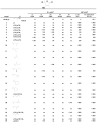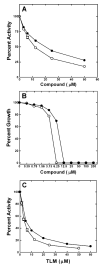Structure-activity relationships at the 5-position of thiolactomycin: an intact (5R)-isoprene unit is required for activity against the condensing enzymes from Mycobacterium tuberculosis and Escherichia coli
- PMID: 16392800
- PMCID: PMC1462948
- DOI: 10.1021/jm050825p
Structure-activity relationships at the 5-position of thiolactomycin: an intact (5R)-isoprene unit is required for activity against the condensing enzymes from Mycobacterium tuberculosis and Escherichia coli
Abstract
Thiolactomycin inhibits bacterial cell growth through inhibition of the beta-ketoacyl-ACP synthase activity of type II fatty acid synthases. The effect of modifications of the 5-position isoprenoid side chain on both IC(50) and MIC were determined. Synthesis and screening of a structurally diverse set of 5-position analogues revealed very little tolerance for substitution in purified enzyme assays, but a few analogues retained MIC, presumably through another target. Even subtle modifications such as reducing one or both double bonds of the diene were not tolerated. The only permissible structural modifications were removal of the isoprene methyl group or addition of a methyl group to the terminus. Cocrystallization of these two inhibitors with the condensing enzyme from Escherichia coli revealed that they retained the TLM binding mode at the active site with reduced affinity. These results suggest a strict requirement for a conjugated, planar side chain inserting within the condensing enzyme active site.
Figures











Similar articles
-
X-ray crystal structure of Mycobacterium tuberculosis beta-ketoacyl acyl carrier protein synthase II (mtKasB).J Mol Biol. 2007 Feb 16;366(2):469-80. doi: 10.1016/j.jmb.2006.11.006. Epub 2006 Nov 7. J Mol Biol. 2007. PMID: 17174327 Free PMC article.
-
Biphenyl-based analogues of thiolactomycin, active against Mycobacterium tuberculosis mtFabH fatty acid condensing enzyme.Bioorg Med Chem Lett. 2003 Nov 3;13(21):3685-8. doi: 10.1016/j.bmcl.2003.08.015. Bioorg Med Chem Lett. 2003. PMID: 14552758
-
Slow onset inhibition of bacterial beta-ketoacyl-acyl carrier protein synthases by thiolactomycin.J Biol Chem. 2010 Feb 26;285(9):6161-9. doi: 10.1074/jbc.M109.077909. Epub 2009 Dec 16. J Biol Chem. 2010. PMID: 20018879 Free PMC article.
-
A missense mutation in the fabB (beta-ketoacyl-acyl carrier protein synthase I) gene confers tiolactomycin resistance to Escherichia coli.Antimicrob Agents Chemother. 2002 May;46(5):1246-52. doi: 10.1128/AAC.46.5.1246-1252.2002. Antimicrob Agents Chemother. 2002. PMID: 11959552 Free PMC article.
-
Isoprene.Adv Biochem Eng Biotechnol. 2015;148:289-317. doi: 10.1007/10_2014_303. Adv Biochem Eng Biotechnol. 2015. PMID: 25627100 Review.
Cited by
-
Thiolactomycin-Based Inhibitors of Bacterial β-Ketoacyl-ACP Synthases with in Vivo Activity.J Med Chem. 2016 Jun 9;59(11):5377-90. doi: 10.1021/acs.jmedchem.6b00236. Epub 2016 May 24. J Med Chem. 2016. PMID: 27187871 Free PMC article.
-
Structural Characterisation of the Beta-Ketoacyl-Acyl Carrier Protein Synthases, FabF and FabH, of Yersinia pestis.Sci Rep. 2015 Oct 15;5:14797. doi: 10.1038/srep14797. Sci Rep. 2015. PMID: 26469877 Free PMC article.
-
Identification of 2-aminothiazole-4-carboxylate derivatives active against Mycobacterium tuberculosis H37Rv and the beta-ketoacyl-ACP synthase mtFabH.PLoS One. 2009;4(5):e5617. doi: 10.1371/journal.pone.0005617. Epub 2009 May 19. PLoS One. 2009. PMID: 19440303 Free PMC article.
-
Novel tetracyclic structures from the synthesis of thiolactone-isatin hybrids.Beilstein J Org Chem. 2010 Jul 19;6:78. doi: 10.3762/bjoc.6.78. Beilstein J Org Chem. 2010. PMID: 20703386 Free PMC article.
-
C4-alkylthiols with activity against Moraxella catarrhalis and Mycobacterium tuberculosis.Bioorg Med Chem. 2011 Nov 15;19(22):6842-52. doi: 10.1016/j.bmc.2011.09.030. Epub 2011 Oct 1. Bioorg Med Chem. 2011. PMID: 22014754 Free PMC article.
References
-
- http://www.who.int/mediacentre/factsheets/fs104/en/ http://www.who.int/mediacentre/factsheets/fs104/en/ WHO Tuberculosis Fact Sheet No. 104.
-
- Michison DA. Basic Concepts in the Chemotherapy of Tuberculosis. In: Gangadharam PRJ, Jenkins PA, editors. Mycobacteria II. Chemotherapy. Chapman & Hall; New York: 1998. pp. 15–50.
-
- Duncan K, Barry CE., 3rd Prospects for new antitubercular drugs. Curr. Opin. Microbiol. 2004;7:460–465. - PubMed
Publication types
MeSH terms
Substances
Grants and funding
LinkOut - more resources
Full Text Sources
Chemical Information
Molecular Biology Databases

